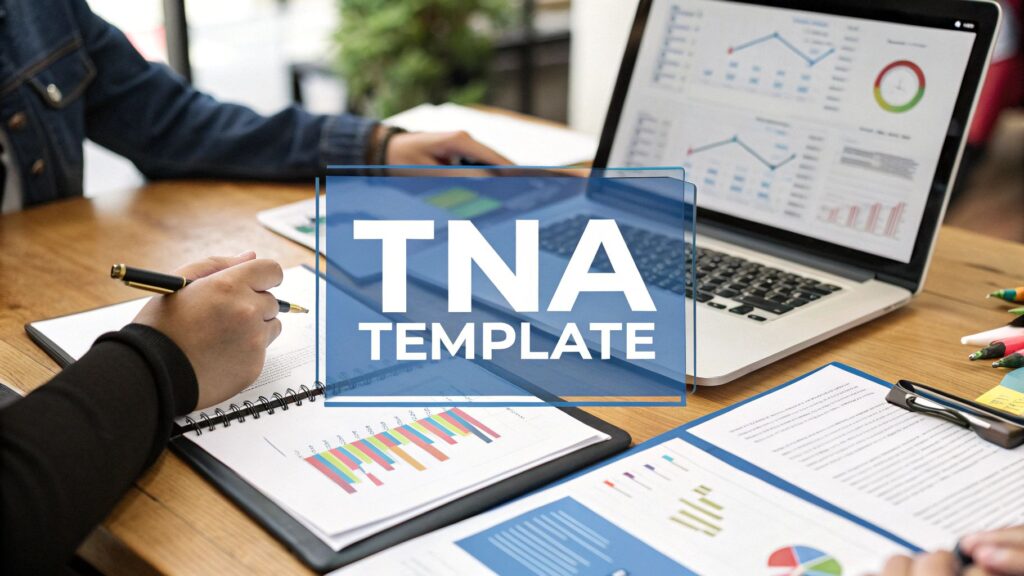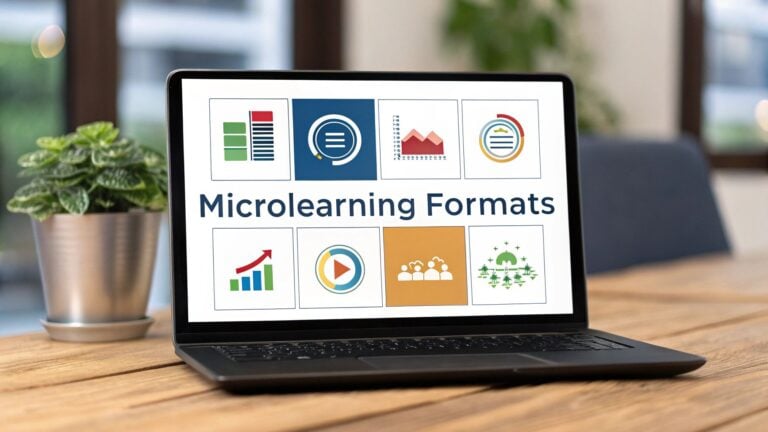Your Training Needs Assessment Template That Works

Getting employee training organized can feel like pure guesswork.
I’ve found that a training needs assessment template can help you plot a clear path. It stops the guesswork and helps you build the skills your team really needs to succeed.
A training needs assessment template stands out as a powerful tool in your learning and development toolkit.
Why a TNA Template Is Your Secret Weapon
I know your team needs to grow. Figuring out where to start can be tough.
If you pick training topics at random, it feels like throwing darts in the dark. You might hit something now and then, but you’ll probably miss the mark more often.
A solid training needs assessment (TNA) template changes that.

Think of a TNA template as your secret weapon for building a smarter, more capable team.
You shift from reactive, unstructured training to a proactive, data-driven approach. Instead of hoping a workshop will be useful, you know it addresses a real skill gap.
Connect Training to Real Business Goals
One big win with a TNA template is getting leadership on your side.
Picture this. You walk into a meeting and say, “our sales are down 15% in this region. Our assessment shows the team needs stronger modern negotiation tactics.”
You just spoke their language. You made the link from training to business outcomes.
A TNA template helps you build a strong business case for training. It goes beyond employee development. You solve real organizational problems and improve the bottom line.
That approach shows the training budget is an investment, not an expense. You get the concrete data you need to justify time and resources for effective learning programs.
A Quick Look at the Process
A good TNA template breaks the process into manageable phases. Here’s a quick snapshot of what that looks like in practice.
| Phase | Key Objective | What You’ll Do |
|---|---|---|
| Planning | Define the scope and goals of your assessment. | Get stakeholder buy-in, identify the target group, and choose your assessment methods. |
| Data Collection | Gather information on current skill levels and performance. | Use surveys, interviews, observations, and performance data to see what’s really happening. |
| Analysis | Pinpoint the specific gaps between current and desired skills. | Compare the data you collected against business goals and performance benchmarks. |
| Action Plan | Develop a targeted training strategy based on your findings. | Prioritize needs, design or select training programs, and create a budget and timeline. |
Many successful companies use this process for good reason. A recent survey found that 76% of companies using these templates saw a measurable increase in training program effectiveness within one year.
You can dig deeper into why TNA is so important to see the full impact.
This approach makes a real difference, not just a tick-box exercise.
Laying the Groundwork for Your Assessment
Before you dive into surveys and interviews you need a plan.
Without a solid blueprint you end up guessing again. That leads to training that misses the mark.
Think of this first phase as drawing a map before you start the journey.
It is all about setting clear goals for your assessment.
Ask yourself what you really want to accomplish.
Is the goal to boost team productivity? Cut down on costly errors? Get everyone up to speed on a major software update?
Defining this early keeps your efforts focused and measurable.
Define the Scope and Get Everyone on Board
A common trap in any assessment is scope creep. That slow expansion where the project keeps growing until it seems endless. I have seen this many times.
To avoid it, define your scope clearly from day one.
First, you need to decide which departments or roles to focus on. Are you looking at the whole organization or just the sales team? Being specific stops your assessment from turning into a never ending, resource drain.
Next, it’s time to bring in the right stakeholders. This goes beyond a simple thumbs-up from department heads. You need real input from the people who will do the training and the managers who oversee their daily work.
Here is my non-negotiable list of people to talk to:
- Senior Leaders They connect the dots between your training goals and the company’s big-picture objectives
- Department Managers They know their team’s performance, challenges, and hidden skill gaps best
- Front-Line Employees They handle the work day in and day out and can tell you what obstacles they face
When you involve people from all levels you are building a coalition of supporters. This is important because these are the people who will be invested in the outcome because they helped shape it from the start.
Frame the “Why”
How we talk about the assessment matters as much as how we run it. Nobody wants to feel tested or under a microscope. That only leads to guarded, unhelpful answers.
I frame the training needs assessment template as a positive opportunity for growth. I explain that we are not finding fault. We are building better, more relevant training that helps everyone do their jobs well and pick up new skills.
When you link the assessment to a competency based training framework you give people a clear, tangible path for development. They are far more likely to join in honestly when they understand the reason behind it.
Gathering the Right Information the Right Way
Now comes the fun part. Data collection. This is where the training needs assessment template comes alive with real insights.
The goal is to uncover the actual skill gaps on your team. Trust me, this does not mean sending out a generic questionnaire and hoping for the best. I’ve done that before, and it doesn’t work!

Choosing Your Data Collection Tools
You have several tools to choose from when it comes to collecting the data, and the best approach often involves more than one method. Each tool brings its own strengths based on what you want to learn.
Select one, or more, of the following methods:
Surveys and Questionnaires They are great for gathering lots of data from many people quickly. Use them to measure baseline knowledge or capture employee perceptions across the organization
One-on-One Interviews If you need to dig into the reasons behind performance issues nothing beats a direct conversation. You can ask follow-up questions and understand the nuances of an individual’s challenges
Focus Groups A small group discussion can spark ideas and reveal shared challenges you did not see before. This is a good way to gauge team dynamics and spot training needs that affect a whole department
Direct Observation Sometimes the best way to spot a skill gap is to simply watch people at work. Observing employees in their natural environment gives you real-time insights into how they follow processes and where they might struggle
Match the method to your goal. For a company-wide initiative, start with a broad survey. For a specific team with a nagging performance issue, you might blend observation with one-on-one interviews. That can give you deeper, more actionable information.
A Real-World Example in Healthcare
Let’s run through an example so that you can see this theory in action. For this example, we’ll assume that you’re in the healthcare industry. A well-designed questionnaire can offer detailed insights that help create training for everyone from nurses to physicians.
The goal is to get honest answers you can act on. Your questions should be direct and focused on uncovering behaviors or knowledge gaps not just general feelings.
One proven tool is the Hennessy-Hicks Training Needs Analysis questionnaire. It has been adopted in over 10 countries because of its success in pinpointing training gaps among healthcare roles. Since 2021 it has been cited in research studies over 70 times.
And tha’ts the point. This shows how a validated instrument can turn your assessment from guesswork into a data-backed process. You can read the full research about its applications to see the power of a structured approach.
By choosing your methods carefully and crafting thoughtful questions you will gather the high-quality information you need to build training that makes a difference. If one doesn’t exist specific to your industry, then that’s okay. You can always emulate existing ones!
Your Customizable Training Needs Assessment Template
Now for the good stuff. Here is a practical, customizable training needs assessment template you can use right away.
I built this to be more than a static document, but an interactive tool to help you pinpoint where your team needs to grow.
I will walk you through each part of the template so I can tell you what each section does and share real-world examples of how you might fill it out. My goal is to make you comfortable adapting it to your team and business goals.
This flowchart shows how you move from high-level business objectives to the specific gaps you need to fill.

Breaking Down the Template Sections
Let us walk through the key fields in the template. When you know the reason behind each one you will gather more useful information.
- Job Role & Department This seems obvious but it matters for later analysis. It lets you slice data by team or function. You might discover that your whole IT department needs training on a security protocol not just one or two people
- Current Competencies List the skills an employee or team already has. Be specific. Instead of writing “good communicator” say “effectively presents quarterly reports to stakeholders”. That gives you a solid baseline
- Desired Skills/Competencies Here you link everything to your business goals. What new abilities do you need to hit those targets? For a sales team that aims to boost its closing rate a desired skill could be “mastering advanced negotiation and objection-handling techniques”
The cool stuff happens when you compare current competencies with desired skills. The space between those two points is your training gap. That is where you focus your energy and budget.
Filling Out Your Template: A Couple of Examples
Let us make this less abstract. Here are two scenarios you might face.
Scenario 1: The Sales Team
Imagine a sales team that struggles to close larger, more complex deals. Their manager uses the template.
- Job Role Account Executive
- Current Competencies Strong product knowledge and great at building initial rapport with new leads
- Desired Skills Ability to create and present custom value propositions for enterprise clients and proficiency in using the new CRM for sales forecasting
- Perceived Barriers Lacks confidence when speaking to C-level executives and is not familiar with advanced CRM features
Scenario 2: The IT Department
Say your company is moving its infrastructure to the cloud.
- Job Role IT Support Specialist
- Current Competencies Proficient at maintaining on-premise servers and experienced with the current ticketing system
- Desired Skills Certified in AWS or Azure fundamentals and skilled in migrating applications to the cloud
- Perceived Barriers Limited hands-on experience with cloud platforms and a heavy daily workload that leaves little time for study
These two simple examples show how the template moves you beyond vague needs. You are not just saying the sales team needs training. You are pinpointing exactly what they need to learn and what is standing in their way.
If you build a course from these findings our 50-point checklist for an online course launch can help you keep all the moving parts organized.
You have done the legwork, and have sifted through surveys, interview notes, and observations. Now, you have a mountain of data and you might wonder where to start.
This is where raw information becomes a clear, actionable strategy. We move beyond spreadsheets. We focus on connecting the dots.

Prioritizing Your Training Initiatives
Once you spot the key training needs you hit reality. You cannot tackle everything at once.
Some needs are urgent five-alarm fires. Others are important but less urgent projects for long-term growth.
I use a simple framework to cut through the noise. For each training initiative ask two questions
- Impact How much will closing this skill gap move the needle
- Urgency How quickly do we need to fix this to avoid a bigger problems
Anything high on both impact and urgency goes to the top of the list.
For instance, a need that is low-impact but high-urgency can be a quick win. This approach forces you to make objective choices based on business value not on which team is the loudest.
Creating a Compelling Report for Stakeholders
Your last step is to package your findings into a report that earns a yes. This is the business case for the investment you propose. It needs to be persuasive.
Your action plan is the bridge between finding a problem and fixing it. It should clearly outline the need, the proposed solution, and the expected outcome in a way that gets everyone on board.
This process scales up too. Large organizations like the World Bank use their own tool called STAT to help national agencies in Colombia and Ghana gather assessment data and build learning plans. These plans tackle skill gaps because they are built on prioritized needs.
Your report must outline proposed solutions.
- Will it be an in-house workshop?
- An external certification?
- A series of online modules?
Think about how you will deliver the training. You might even want to look at our guide on gamification for elearning to find ways to make the experience more engaging and effective.
Finally include a realistic budget and timeline. This shows you have done your homework, thought through the entire process, and are ready to move forward.
Got Questions About Training Needs Assessments?
Look, running a training needs assessment survey seems complicated, but I promise you that it isn’t. That said, you want to get it right. Let us tackle some of the important questions now so you can start with confidence.
How Often Should I Actually Run One of These?
There is no magic number. A good rule of thumb is to do a full-scale assessment annually. That rhythm usually lines up with yearly budgets and planning cycles, making it a natural part of business life.
But don’t stop there.
Think of it as an ongoing conversation not a once-a-year event. Plan smaller, targeted assessments whenever there is a big change. This might be a software rollout, a shift in strategy, or spotting a dip in a department’s performance.
What Are the Biggest Mistakes People Make?
One common pitfall is when leaders assume they know what training everyone needs. This top-down approach wastes time and money on programs that do not solve the real issues.
Also, another mistake is poor communication. If you do not explain why you are doing the assessment your team may get anxious. They might feel tested or under a microscope and that stops honest feedback.
The absolute worst mistake is failing to act on the results. That is, if you ask for input and then do nothing you lose credibility. It gets much harder to earn buy-in for any future initiative.
How Do I Get Employees On Board with This?
Getting your team on board all comes down to transparency. Frame the assessment as what it is. A positive chance to grow professionally and make their work easier.
Be clear that this is not a test to find faults. It is a tool to make training useful and relevant to their daily work and long-term goals.
Involving employees directly builds trust. Here are some steps
- Run focus groups Let people share their thoughts and frustrations in a low-pressure setting. You will be surprised by what you learn
- Ask for volunteers Find people from different teams to pilot your survey or questionnaire. Their feedback is invaluable
- Share the results and the plan After you analyze the data show how their feedback shaped the training plan
In the end, when people feel heard and see their input lead to real action they are more likely to engage with the whole process






